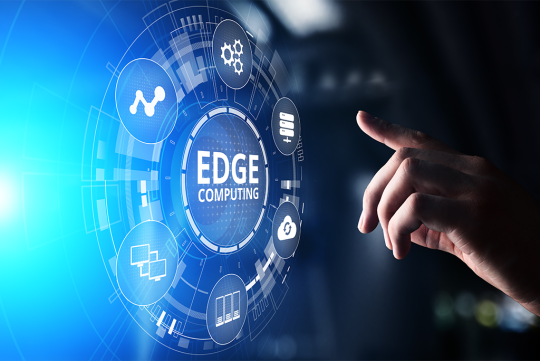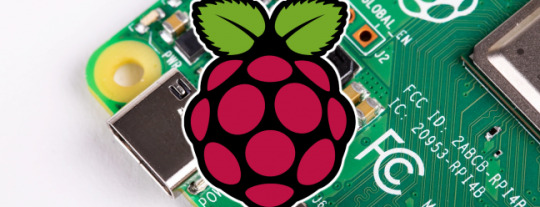#EdgeDevices
Explore tagged Tumblr posts
Text
#edgecomputing#iot#cloudcomputing#digitaltransformation#dataanalytics#cybersecurity#artificialintelligence#smartcities#5g#internetofthings#edgecomputingmarket#technology#innovation#datamanagement#edgedevices#edgecomputingsolutions#businessstrategy
0 notes
Text
Edge Computing: Revolutionizing Connectivity and Data Management Across Industries
The global edge computing market size is expected to reach USD 155.90 billion by 2030, and is expected to expand at 36.9% CAGR from 2024 to 2030, according to a new report by Grand View Research, Inc. Artificial Intelligence (AI) integration into the edge environment is projected to drive market growth. An edge AI system is estimated to help businesses make decisions in real time in milliseconds. The need to minimize privacy concerns associated while transmitting large amounts of data, as well as latency and bandwidth issues that limit an organization's data transmission capabilities, are factors projected to fuel market growth in the coming years.

Edge Computing Market Report Highlights
Over the projected period, the edge server segment is expected to be the booming hardware segment. The increased demand for edge servers throughout several industrial verticals accounts for the segment's promising growth prospects
In terms of application, the AR/VR segment is projected to progress at a substantial CAGR because of the developing cellular network, which offers potential development for edge computing. For instance, to provide a high-quality VR experience to users, Ericsson has improved its radio infrastructure and 5G core
In terms of industry vertical, the data center segment is projected to experience the highest CAGR over the estimated period. This can be ascribed to the fact that edge data centers overcome inconsistent connections and compute and store data close to the end-user
The Asia Pacific region is anticipated to expand at the highest CAGR over the estimated period due to the advent of 5G in the region and the increasing number of IoT-incorporated devices. The evolution of telco edge infrastructure to support 5G-enabled applications is expected to be accelerated by the launch of 5G networks
For More Details or Sample Copy please visit link @: Edge Computing Market Report
Machinery control and precision monitoring are a few use cases that are well-suited for AI on the edge. The latency requirement for a fast-running production line must be maintained to a bare minimum, which can be accomplished by using edge computing. Bringing data processing closer to the manufacturing facility can prove to be extremely important, which can be accomplished using AI. Artificial intelligence-based edge devices can be utilized in a wide range of end-point devices, including sensors, cameras, smartphones, and other IoT devices.
Moreover, the telecom edge is estimated to grow exponentially over the projected period. The telecom edge executes computing adjacent to the telco's mini-data centers, which are operated on the telco-owned property. Several telecom operators, including Telstra and Telefonica, are developing prototypes and pilot projects of open-access networks integrated with edge computing. Edge will be at the forefront of the telecom industry once 5G technology is fully deployed. The telecom industry is in a great position to enhance edge computing, but telecom businesses risk being abridged by irrelevant edge suppliers if they do not move up the value chain.
Presently, Edge computing use cases have outpaced initial infrastructure deployments, and are projected to provide momentum to edge computing infrastructure and use case investments. Edge computing is predicted to become more ubiquitous and evolve toward platform-centric solutions over the projection period. With this development, edge platforms can reduce the infrastructure intricacy using orchestration software and sophisticated management, and provide user-friendly environments for programmers to implement innovative edge services and applications.
#EdgeComputing#DecentralizedData#IoT#CloudComputing#EdgeDevices#DataAnalytics#InternetOfThings#DistributedComputing#DigitalTransformation#RealTimeProcessing#EdgeInfrastructure#EdgeSecurity#NetworkOptimization#EdgeApplications#Industry40#CyberPhysicalSystems#EdgeDeployment#EdgeSolutions#EdgeNetworking#EdgeAI
0 notes
Text
New Oracle Roving Edge Device Revolutionizes AI At The Edge

Oracle’s second-generation Roving Edge Device (RED), the newest product in the company’s e Edge Cloud line, offers exceptional processing power, smooth connection, and integrated security at network edges and in remote areas. Numerous workloads, including corporate applications, AI, and certain OCI services, may be operated at the edge with Roving Edge Device(RED) because to its easy deployment, great price-performance, and better security, which includes the option to run isolated or air-gapped.
What is Oracle Roving Edge Device?
OCI cloud computing and storage are made possible at network edges and in remote areas via the Oracle Roving Edge Device (RED), a portable hardware platform with cloud-integrated services.
The second version of the Roving Edge Device builds upon a strong foundation created to satisfy the requirements of security applications. It not only improves basic capabilities but also adds customized configurations to satisfy business needs in a range of sectors.Image Credit To Intel
Introducing the second generation Oracle RED
With more OCPUs, RAM, storage, and better GPU performance, the second iteration of the Oracle Roving Edge Device offers significant improvements over the first generation.Image Credit To Intel
RED is available in three configurations to suit diverse business
Where can you deploy Oracle Roving Edge Device?
In your data center or at the edge, RED offers the same OCI development and deployment methods, selectable OCI services, and CPU and GPU forms. This drives development in many industries and technical advancement in today’s fast-paced commercial environment. Due to its unrivaled processing power, smooth connectivity, and steadfast security, the Roving Edge Device is ideal for cutting-edge applications that need speed, dependability, and efficiency.
Improvements in performance with the second-generation RED
Milliseconds matter in the fast-paced world of artificial intelligence. Imagine a future in which your network’s borders are infinite and its edge gets exponentially more intelligent. Customers now have more deployment options with to Oracle Roving Edge Device 2nd Generation (RED), which has a new GPU-optimized configuration with compute- and storage-optimized configuration.
Customers gain from low-latency processing nearer the point of data production and ingestion by utilizing the Intel Xeon 8480+ processor’s capability at the edge, which leads to more timely insights into their data. Oracle and Intel collaborated to perform a number of benchmarks over the first-generation RED in order to test this capability.
It used only Intel Xeon processors to run the Llama 2-7B, Yolov10 model, and Resnet50 convolutional neural network (CNN) for the testing. The Intel Xeon 6230T-based first-generation Roving Edge Device is compared to the Intel Xeon 8480+-based second-generation using the following benchmarks:
Deploying Llama2-7B on RED
An autoregressive, transformer architecture serves as the foundation for the Llama 2 family of pre-trained and optimized text generation models. Three models with seven billion, thirteen billion, and seventy billion parameters are included with Llama 2. Oracle benchmarked the Llama 2 7 billion parameter model for this simulation.
Using the Llama 2-7B model, the second-generation Roving Edge Device may achieve response rates up to 13.6 times faster than RED Gen 1, allowing for lightning-fast performance for edge-based large language model (LLM) inferencing. Enhancement of Throughput Intel Xeon 8480+ Processor.
Using the Llama2-7B paradigm, the RED Gen 2 may achieve up to 12.4 times higher throughput, greatly increasing the edge’s capacity for processing LLM data.
YOLO v10
Real-time object identification and precise, low-latency object category and location prediction in pictures were the goals of the YOLO family of models. Oracle compared using the YOLO v10 model on the two versions of Roving Edge Device in this set of benchmarks.
Up to 60% more performance may be achieved by the new RED generation than by the old one. YOLO v10 increased throughput by 67%.
ResNet-50
A convolutional neural network (CNN) architecture called ResNet-50 is a member of the Residual Networks (ResNet) family, a group of models created to tackle the difficulties involved in deep neural network training. Renowned for its depth and effectiveness in image classification tasks, ResNet-50 was created by researchers at Microsoft Research Asia. There are several levels of ResNet topologies, including ResNet-18 and ResNet-32, with ResNet-50 being a mid-sized version.
Using the ResNet 50 CNN, the second generation achieves a response rate that is up to three times higher than the first.
Why deploy with Oracle Roving Edge Device?
Oracle Roving Edge Device is the best option if you need to deploy application workloads at the edge and need a scalable, secure, and adaptable platform with the advantages of cloud computing and cost-effectiveness. Built to execute time-sensitive, mission-critical applications at the edge in both connected and unconnected areas, it is a powerful cloud-integrated service.
Getting Started
Oracle Roving Edge Device is the perfect infrastructure for anybody seeking a high-security, low-latency data processing and scalable environment at the edge because of its affordable, adaptable configurations and capacity to serve computing, storage, and GPU-intensive applications.
Read more on govindhtech.com
#OracleRovingEdgeDevice#RevolutionizesAI#cloudcomputing#artificialintelligence#Llama2#IntelXeonprocessors#YOLO#GettingStarted#convolutionalneuralnetwork#CNN#EdgeDevice#technology#technews#news#govindhtech
0 notes
Photo

🌟 AMD is challenging NVIDIA’s AI reign! 🌟 As AI demands shift, AMD is betting big on **edge devices** for AI inference, signaling a major industry change. CTO Mark Papermaster shares: A significant shift is underway, with edge AI poised to transform phones and laptops into AI powerhouses, challenging costly data center reliance. 💡 **Why tech giants like Microsoft, Meta, and Google are eyeing Edge AI:** - **Cost Efficiency:** Lower AI compute costs with AMD’s APUs, like the Strix Point series. - **Performance:** The Ryzen AI MAX+ 395 outpaces top competitors. - **Future Thinking:** “The switch is driven by the evolution of edge-ready apps,” says Papermaster. Can AMD edge out NVIDIA in the AI landscape? Let’s explore the future of AI tech! What do you think about AI’s shift to edge devices? Share your thoughts! 🔥 #AMD #EdgeDevices #TechInnovation #AI #NVIDIA #Ryzen #FutureTech #Innovation #AITech #ComputingRevolution
0 notes
Text
🧠💾 Brain-Inspired Chips? Neuromorphic Tech Is Growing FAST!
Neuromorphic semiconductor chips are revolutionizing AI hardware by mimicking the biological neural networks of the human brain, enabling ultra-efficient, low-power computing. Unlike traditional von Neumann architectures, these chips integrate spiking neural networks (SNNs) and event-driven processing, allowing real-time data analysis with minimal energy consumption.
To Request Sample Report : https://www.globalinsightservices.com/request-sample/?id=GIS10673 &utm_source=SnehaPatil&utm_medium=Article
By leveraging advanced semiconductor materials, 3D chip stacking, and memristor-based architectures, neuromorphic chips significantly improve pattern recognition, autonomous decision-making, and edge AI capabilities. These advancements are critical for applications in robotics, IoT devices, autonomous vehicles, and real-time medical diagnostics, where low-latency, high-efficiency computing is essential. Companies like Intel (Loihi), IBM (TrueNorth), and BrainChip (Akida) are pioneering neuromorphic processors, paving the way for next-generation AI solutions that operate closer to biological cognition.
The integration of analog computing, in-memory processing, and non-volatile memory technologies enhances the scalability and performance of neuromorphic chips in complex environments. As the demand for edge AI, neuromorphic vision systems, and intelligent sensors grows, researchers are exploring synaptic plasticity, stochastic computing, and hybrid digital-analog designs to further optimize efficiency. These chips hold promise for neuromorphic supercomputing, human-machine interfaces, and brain-computer interfaces (BCIs), driving innovations in AI-driven healthcare, cybersecurity, and industrial automation. With the convergence of AI, semiconductor technology, and neuroscience, neuromorphic semiconductor chips will be the cornerstone of next-gen intelligent computing architectures, unlocking unprecedented levels of cognitive processing and energy-efficient AI.
#neuromorphiccomputing #aihardware #braininspiredcomputing #semiconductortechnology #spikingneuralnetworks #neuromorphicsystems #memristors #analogcomputing #intelligentprocessors #machinelearninghardware #edgedevices #autonomoussystems #eventdrivenprocessing #neuralnetworks #biomimeticai #robotics #aiattheneuromorphicedge #neuromorphicvision #chipdesign #siliconneurons #futurecomputing #hpc #smartai #inmemorycomputing #lowpowerai #bci #nextgenai #deeptech #cybersecurityai #intelligentsensors #syntheticintelligence #artificialcognition #computervision #braincomputerinterfaces #aiinnovation
0 notes
Text
16 Cool Projects for Your New Raspberry Pi 4


The Raspberry Pi Foundation Whether you're in the market for a Pi 4 or you already have one sitting alone in a drawer, you're probably in need of some cool project ideas. Don't fret—you have a ton of options. Why Are These Projects Suited for the Pi 4? Most of the projects that we're listing... Link: 16 Cool Projects for Your New Raspberry Pi 4 via www.reviewgeek.com Read the full article
4 notes
·
View notes
Text
MAC IP-Custom SoC for IoT Edge Devices
In the event that this assault is focused on one client, the Attack can simply parody the casualty's MAC to his own and just influence that MAC on the subnet. Remember that the entryway (router)is intended to have bigger steering tables and numerous meetings associated with it without a moment's delay. Most PCs cannot deal with an excessive number of courses and meetings so the aggressor's PC must be a quick PC (this relies upon the volume of traffic on the subnet) to stay aware of the progression of information.
48-bit address called its Ethernet address or Media Access Control (MAC) address. Macintosh addresses are typically addressed as six colon-isolated sets of hex digits this number is novel and is related to a specific Ethernet gadget. We offer Ethernet IP Subsystem, Ethernet MAC IP, the information interface layer's convention explicit header is determined. The MAC address of the bundle's source and objective. At the point when a parcel is shipped off to all hosts (broadcast), a unique MAC address is utilized. Presently with this idea covered we wanted to clarify what APR is and how it relates to the MAC address.
The Address Resolution Protocol is utilized to powerfully find the planning between a layer 3 (convention) and a layer 2 (equipment) address. ARP is utilized to powerfully construct and keep a planning information base between interfaces nearby layer 2 locations and layer 3 locations. In the normal case, this table is for planning Ethernet to IP addresses. This data set is known as the ARP Table. The ARP Table is the genuine source with regards to directing traffic on a Switch (layer 2 gadget). So what you wind up having is one PC (assailant) sees all traffic on the network.
At times, an organization can crash or freeze in case the assailant's PC can't course the information adequately. The organization Crashes due to the number of parcels dropping because of the reality the Attacker PC can't stay aware of the progression of information. In the course of recent weeks, I have gotten many messages about Ethernet cards, both wired and remote, and all the more explicitly, about Media Access Control (MAC) addresses.
I think the primary explanation I've gotten such countless inquiries regarding Ethernet cards and MAC addresses is individuals attempting to tie down their home remote organizations and their longing to utilize MAC addresses separately. Offering silicon wafer manufacturing process including 5nm, 7nm, 12nm, 16nm, 2.5D packaging technology, custom soc for iot edge devices, ASIC/SoC physical design, SoC micro architecture. This sort of separation in remote organizations can be arranged to permit or deny explicit PCs to utilize or join the remote organization, in light of the MAC address. I initially thought was to compose an article pretty much MAC locations and remote Ethernet.
In the wake of pondering it, I chose to develop this and go over some particular data about Ethernet cards and correspondence.
The Ethernet Switch peruses the Source MAC Address and adds that location to a MAC Address Table. This table is frequently alluded to as Content Addressable Memory (CAM). Inside the table, the MAC Address is related to the actual port on the change to which the organization gadget is connected. The switch currently realizes which port to advance information to when an Ethernet outline shows up from somewhere else in the organization, since it actually takes a look at the objective MAC Address, and searches for a match in the table.
The Destination MAC Address is consequently utilized by the Ethernet Switch to advance information out of the right port to arrive at the right actual interface.
The requirement for custom PC conventions for business will stay as long as innovation advances however the plans that drive them have additionally improved and will keep on improving. Usually, Apple's Mac OS is the main decision of computerized workmanship and configuration firms. An ever-increasing number of specialists who work with computerized print, video, and sound, depending on Mac figuring to proceed as the publication spine while doing pre and after creation.
An originator can undoubtedly deliver content-rich items individuals pay for on paper, video, and sound utilizing Apple's Mac OS X stage. Utilizing the most ideally equipped devices for the work guarantees a top-notch item and the creation organization can vie for more work and better compensation.
Creation organizations get what they need with Mac OS X. Presently infuse a cutoff time and give these equivalent substance creators no real way to associate carefully. A firm without an organization has editors who work alone. They work alone except if taking a document from one PC and genuinely downloading it onto another PC is considered teaming up. The circumstance is genuine, the lost usefulness is genuine, and the security hazard is genuine. Having more substance fashioners cooperating implies more documents to share.
0 notes
Link
Edge Computing and ITOps: Opportunities and Challengeshttps://t.co/NEzXU3IGAk#Computing #DevOps #ITOps #PrivateCloud #Edge #EdgeDevices
— Whitlock (@WhitlockIS) January 22, 2020
via: https://ift.tt/1GAs5mb
0 notes
Text
Tweeted
Today experimenting with #InfluxDB with #Telegraf #Modbus input plugin. Let see what will happen when we go in production. This is a prototype #EdgeDevice for @ConsultThings's #SenseDigi Solution.
— Umair Iftikhar (@UmairUmi786) July 7, 2020
0 notes
Photo

MIT CSAIL researchers and MIT-IBM Watson AI lab have worked together to create Hardware-Aware Transformers (HAT), an AI training model. HAT can speed up language models by 3xin edge devices. It can decrease the model size by 3.7 times compared to a baseline.
#AI #AImodel #HardwareAwareTransformers #edgedevices #sourcesoft
0 notes